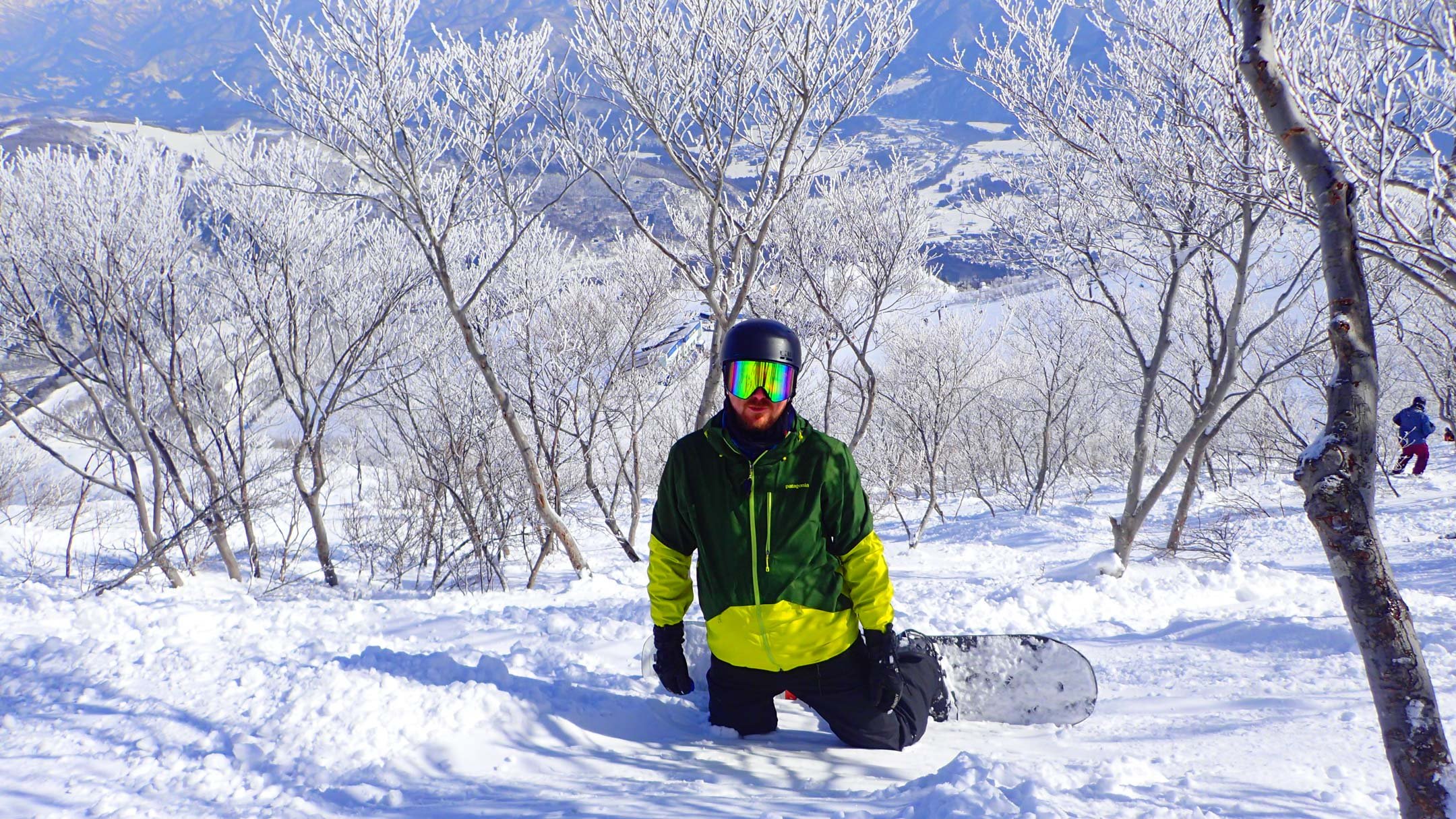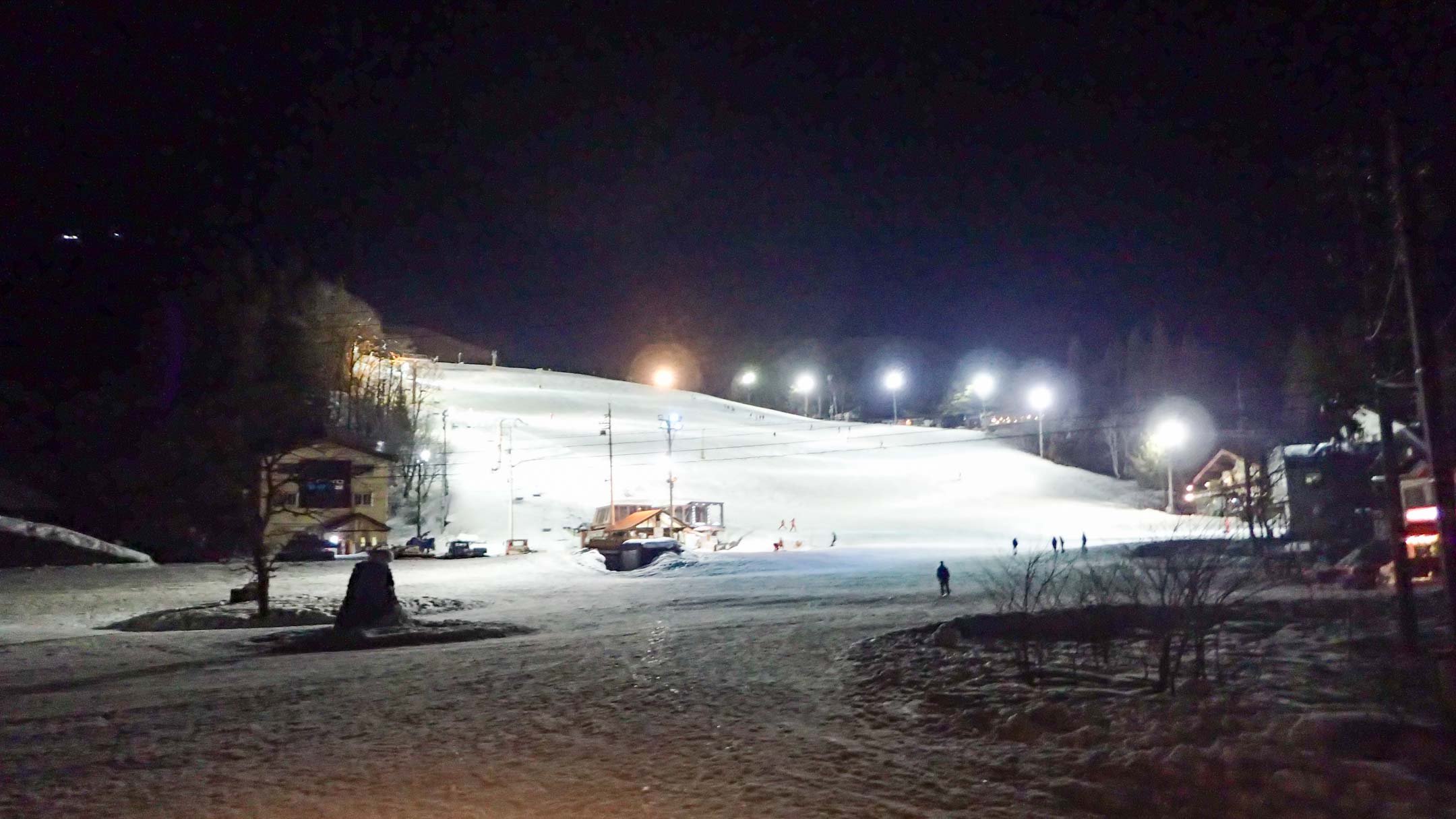Hakuba Happo One
Hakuba Happo One is Hakuba’s best-known resort. Centre stage for the 1998 Nagano Winter Olympics, Happo helped bring Japanese ski resorts to the mainstream. Happo One is in the centre of a purpose-built village and has everything you would expect to find at a premiere ski resort.
If you are visiting Hakuba the purpose built-village surrounding the flagship resort Happo One has a plethora of accommodations, restaurants, ski shops and ski schools. This means for a lot of visitors, Happo will be their closest resort and where they base themselves for the duration of their stay. With multiple base areas, you can actually start your day at Happo from a number of entry points. Nakiyama is home to the local ski school and close to a number of local hire shops. Sakka is the most mellow area and will be where you find the most suitable beginner terrain. Whereas Shirakaba is the base of the main Gondola which will quickly move skiers to mid-mountain. Interestingly at Happo, you have to take a combination of lifts to get to the top meaning one top-to-bottom lap often consists of three lift rides to get back to the peak.
HAPPO ONE FIRST IMPRESSION
Arriving at Happo you soon see why it is the most popular ski resort in the Hakuba Valley. As you get closer to the village and ski lifts you are surrounded by everything you need for your snowboard trip. Each of the base areas is close to rental shops, accommodations and restaurants making Happo One the stress free Hakuba ski destination.
HAPPO ONE SKI AREA
Happo One ski resort is a relatively large resort by Japanese standards and this is one of the reasons people love it. A limited number of pistes doesn’t really tell the story and the resort is really much larger than its stats suggest. There are plenty of steep runs within its 1071m vertical drop, which draw advanced riders to the resort. But don’t be put off if steeps are not your thing, Happo is pretty diverse with four base areas. Nakiyama, Shirakaba, Kokusai and Sakka all offer something a little different and this is what makes Happo so versatile and popular with families.
Happo’s mellow slopes at Sakka will suit those working towards their first turns. Over the rest of the mountain, the wide red slopes are perfect for those looking to blast around. In addition to the groomers, you will find lots of mogul runs and of course the Olympic Downhill track! If backcountry is on your mind then head to the Grat Quad where you will find easy access backcountry within a short hike.
Happo represents the best one resort fits all for a Hakuba trip so if you don’t want to be busing to other resorts basing yourself at Happo is a good option. Additionally, if you don’t want the day to stop head to Nakiyama slopes for some night skiing.
BEGINNER TERRAIN AT HAPPO ONE
There is ample terrain to get beginners moving and exploring the mountain at Happo. Sakka base area is where you will find the majority of beginner runs, although it is worth noting that the green at Nakiyama slope is open for night skiing!
INTERMEDIATE TERRAIN AT HAPPO ONE
Intermediate skiers and snowboarders will love Happo One. There are a number of interesting pistes in addition to the little areas of sidecountry to play in. I enjoyed the long run from the top of the resort down to Nakiyama slope.
ADVANCED TERRAIN HAPPO ONE
Happo hosted the slalom at the Nagano Olympics so the Olympic course is a must for advanced skiers and snowboarders. The Olympic course gives you the opportunity to blast downhill trying to leave your mates in your wake. Additionally, Happo has a number of steep black-graded groomers that are excellent, especially first thing in the morning. For those with the inclination for bumps, you will find plenty of good mogul runs especially if there has been a break in snowfall.
OFF-PISTE AT HAPPO ONE
Sadly, as is common amongst Japanese ski areas, there are a number of closed areas at Happo. This really limits the amount of tree-riding or off-piste you can do here without risking your lift pass in the process. Happo One ski resort has opened an in-bounds tree skiing area but its barely worth it as it is short and gets tracked out rather quickly.
Where Happo excels is the backcountry runs that are accessible from the top of Grat chairlift. Happos highest lift point helps provide access to a series of steep faces that will keep the most avid backcountry snowboarder happy. The local ski schools offer guiding services here which are recommended if you are not familiar with the area.
HAPPO ONE SNOW RECORD
Similarly to the rest of the Hakuba Valley, Happo One gets more than its fair share of snow. Happo One’s location helps draw in 11m of average seasonal snowfall. The snow quality, especially at the top of the resort, is excellent. Happo has a large vertical drop so its lower slopes can suffer towards the end of the season.
LIFTS AT HAPPO ONE
The lift infrastructure at Happo One is a bit strange. 23 lifts in total but it is likely that you will need to take a combination of these lifts to get to the area you wish to ski. There is a gondola and some faster lifts since upgrades but there are also sluggish lifts! Being a popular resort you can find lift queues at Happy especially during holiday or weekend periods.
Gallery









HAPPO ONE PROS
Happo One has backcountry within a short hike
Easy access from the village and main accommodation hubs makes Happo One incredibly accessible
Free shuttles from Happo One to take you to other Hakuba resorts
Happo One has steeper terrain than most Hakuba resorts
Happo One offers fantastic views across the Hakuba valley
Happo One is a great resort for families with a range of terrain so great family resort
HAPPO ONE CONS
Happo One is prone to lift cues caused by a combination of Happo’s popularity and relatively slow lift cues.
Due to the larger crowds at Happo One, if you are looking for first tracks look to another Hakuba ski resort.
Happo closes most of the terrain that may appeal to the more adventurous skiers and snowboarders.
TRAVEL TO HAPPO ONE
Travel to Happo One in Hakuba Valley is most commonly accessed from Tokyo Airport via several convenient options. From either Narita or Haneda Airport, travelers can take the JR Hokuriku Shinkansen to Nagano Station, which takes about 1.5 to 2.5 hours depending on the service. From Nagano Station, a direct bus or taxi can bring you to Hakuba in roughly one hour. Alternatively, there are express airport limousine buses that travel directly from Tokyo airports to Hakuba, offering a comfortable and straightforward journey.
When arriving at Tokyo airports—Narita (NRT) or Haneda (HND)—you have convenient options to ship your luggage directly to your hotel, making travel through the city easier and more enjoyable.
Luggage Delivery Services:
Takuhaibin (宅配便)
This is Japan’s comprehensive door-to-door delivery service, widely used for shipping bags between airports, hotels, and other locations. Major providers include Yamato Transport (Kuroneko Yamato), Sagawa Express, and Japan Post.Where to find service desks: At both Narita and Haneda airports, look for dedicated Takuhaibin counters or kiosks near the baggage claim area or arrivals hall.
Costs: Typically range from 1,500 to 3,000 JPY per bag, depending on size and destination. Expect a fee on the higher end for same-day or next-day delivery.
Time: Delivery generally takes 1 to 2 days, but many Hakuba hotels receive luggage the next day if shipping early.
How to Ship:
Bring your luggage directly to the Takuhaibin counter at the airport.
Provide your hotel’s address, phone number, and your planned check-in date.
Fill out a simple form; staff often can assist in English.
Pay by cash or credit card.
You’ll receive a receipt with a tracking number.
Shipping to Hotels:
Most hotels in Tokyo are familiar with and accept Takuhaibin luggage deliveries for their guests. Always inform your hotel ahead of time with the expected delivery date and provide your name to avoid confusion. Some luxury hotels may charge a small handling fee, so check in advance.Timing and Planning:
Shipping luggage ahead means you can travel light on public transport or have more freedom to explore Tokyo immediately after arrival. However, avoid shipping your bags to hotels with insufficient lead time—send luggage early enough to ensure it arrives before or on your check-in day.
Using luggage forwarding services from Tokyo airports to your hotel significantly simplifies travel logistics, especially when carrying bulky ski or hiking gear. It lets you enjoy a hassle-free arrival and focus on your adventures in Japan.Once in the Hakuba Valley, local shuttle buses provide frequent and reliable service between the various resorts, including Happo One, allowing visitors to easily explore the area without needing their own vehicle. These shuttles connect key points daily, catering to skiers and hikers alike, making the valley highly accessible and convenient to navigate.
GETTING AROUND HAKUBA
Getting around Hakuba is straightforward with the extensive shuttle bus network that connects major ski resorts, hotels, and key points in the valley. These buses run frequently throughout the day, making it easy for visitors to access popular slopes such as Happo-One, Hakuba 47, and Goryu. Shuttle services are typically free or low-cost, often included with lift passes or available through accommodation packages. The system operates on a fixed schedule, so it’s important to check the latest timetables to plan your day efficiently. Using shuttle buses is a convenient way to avoid parking hassles and enjoy stress-free travel across Hakuba’s sprawling ski areas. Taxi’s are also available but are a more expensive option as the shuttle buses are included with your Hakuba Valley ski pass.
HAKUBA VIDEOS
ACCOMMODATION AT HAPPO
Accommodation near Hakuba Happo One ski resort offers a wide variety of options to suit different tastes and budgets. From cozy guesthouses and budget hostels to mid-range hotels and luxury ryokans, there is something for everyone. Popular places to stay include the Hakuba Tokyu Hotel, known for its convenient location and excellent amenities; the Lotte Arai Resort, which offers ski-in ski-out access and high-end facilities; and the comfortable and affordable Happo Lodge, ideal for those seeking a friendly atmosphere. For travelers who prefer self-catering, several apartments and chalets are available, providing a kitchen and living space for greater independence. Whether you prioritize proximity to the slopes, comfort, or cost, Hakuba’s accommodation options provide flexible choices for a memorable ski holiday.
FINAL THOUGHTS ON HAPPO ONE
As previously stated Happo One is probably the best all-rounder in terms of Hakuba ski resorts. Happo One caters perfectly for groups or families with differing abilities. The international crowd will appreciate the amenities and shops that lie close to the Happo’s base areas. Happo One is also a great option for families with skiers of differing abilities as its terrain has something to offer everyone.



